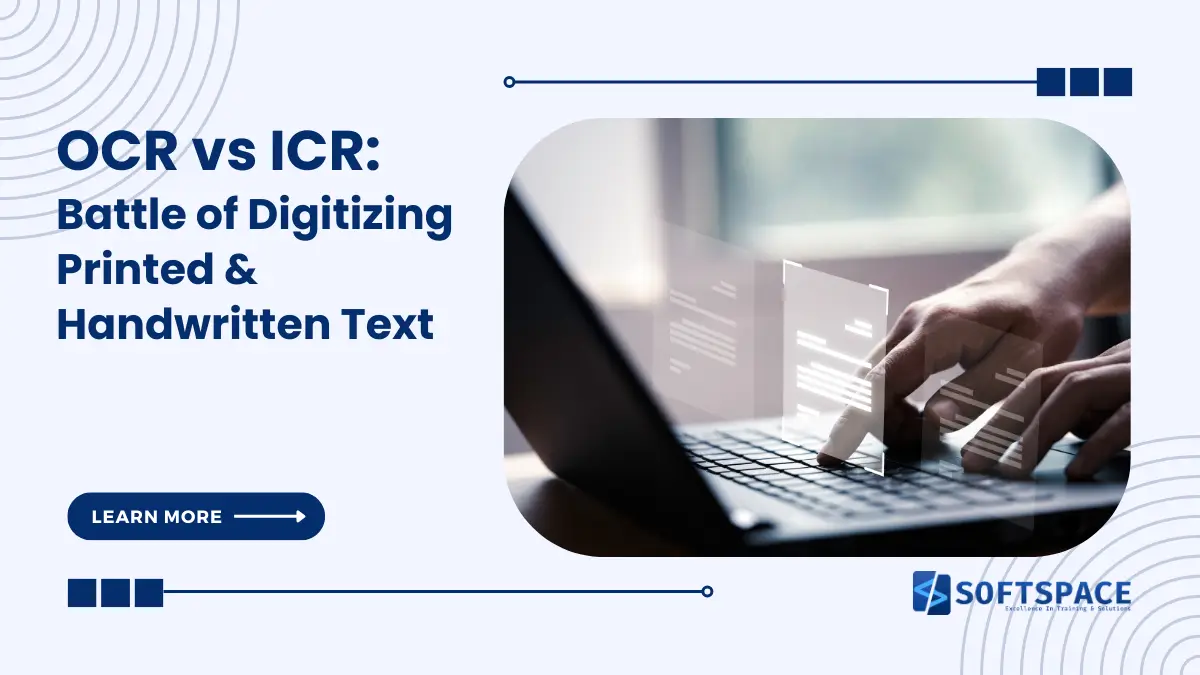In an increasingly digital world, the need to convert physical documents into digital formats has never been more pressing. Whether for archiving, data analysis, or enhancing accessibility, the technology that facilitates this transformation plays a crucial role.
Optical Character Recognition (OCR) and Intelligent Character Recognition (ICR) are two such technologies, each with its own strengths and challenges. OCR vs ICR: They are both technologies used to convert different types of documents, such as scanned paper documents, PDFs, or images captured by a digital camera, into editable and searchable data.
OCR vs ICR: The difference
What is Optical Character Recognition (OCR)?
OCR (Optical Character Recognition) is a technology that converts different types of documents, such as scanned paper documents, PDFs, or images captured by a digital camera, into editable and searchable data.
OCR’s primary function is to recognize and extract text from images. It is highly effective when dealing with printed text, making it an invaluable tool for businesses, libraries, and individuals who need to digitize books, receipts, invoices, and other printed materials.
How Does OCR Work?
The process of OCR involves several steps:
- Image Preprocessing: The quality of the input image significantly impacts the accuracy of OCR. Image preprocessing techniques such as noise reduction, binarization (converting the image to black and white), and deskewing (aligning the text correctly) are essential to enhance image quality.
- Text Detection: The OCR system detects areas of the image that contain text. This step is crucial for identifying text regions and ignoring non-text elements like images and graphics.
- Character Recognition: In this step, the OCR engine analyzes the text regions and recognizes individual characters. Modern OCR systems use machine learning algorithms and neural networks to improve accuracy.
- Post-Processing: After recognizing the characters, the system performs spell-checking and context analysis to correct any errors and improve the overall accuracy of the recognized text.
Key Applications of OCR
OCR technology has a wide range of applications:
● Document Digitization: Converting paper documents into digital formats for easier storage, search, and retrieval.
● Data Entry Automation: Automating the extraction of information from forms and invoices, reducing the need for manual data entry.
● Text Analysis: Enabling the analysis of text data from historical documents, newspapers, and other print media.
● Accessibility: Making printed text accessible to visually impaired individuals through text-to-speech and other assistive technologies.
Image OCR Tools
Numerous OCR tools are available, each with its features and capabilities. Some of the popular Image OCR tools include:
- Tesseract: An open-source OCR engine developed by Google. Tesseract supports multiple languages and provides high accuracy for printed text.
- Picture To Text: It is an online Image OCR tool that allows users to convert scanned images and handwritten notes into editable text with a single click.
- ABBYY FineReader: A commercial OCR software known for its high accuracy and advanced features such as text comparison and document conversion.
- Adobe Acrobat: Widely used for PDF management, Adobe Acrobat includes OCR capabilities for converting scanned documents into editable and searchable PDFs.
What is Intelligent Character Recognition (ICR)?
While OCR excels at recognizing printed text, it struggles with handwritten text due to the variability in handwriting styles. This is where Intelligent Character Recognition (ICR) comes into play. ICR is an advanced form of OCR that not only recognizes printed characters but also handwritten ones. By leveraging machine learning and artificial intelligence, ICR can learn and adapt to different handwriting styles, improving its accuracy over time.
How Does ICR Work?
ICR involves a more complex process than OCR due to the variability in handwriting:
- Image Preprocessing: Similar to OCR, ICR begins with preprocessing to enhance the image quality.
- Text Detection: The system detects text regions, but unlike OCR, ICR must handle a wider variety of shapes and strokes.
- Character Recognition and Learning: ICR uses neural networks trained on vast datasets of handwritten text. The system recognizes individual characters by analyzing the strokes and patterns typical of handwriting.
- Adaptation and Improvement: A key feature of ICR is its ability to improve over time. By analyzing user corrections and feedback, the system refines its algorithms to better handle different handwriting styles.
Key Applications of ICR
ICR technology is particularly useful in scenarios where handwritten text is prevalent:
● Form Processing: Automating the extraction of information from handwritten forms, such as medical records, applications, and surveys.
● Historical Document Digitization: Digitizing and preserving handwritten historical documents and manuscripts.
● Postal Services: Recognizing handwritten addresses on mail for automated sorting and delivery.
● Banking: Processing handwritten checks and financial documents.
OCR vs ICR: Comparing the Technologies
While OCR and ICR share the common goal of digitizing text, they cater to different needs and have distinct advantages:
Accuracy and Complexity
● OCR: Highly accurate for printed text with standard fonts. The technology is mature and well-optimized for dealing with high-quality printed documents. The complexity of OCR lies in preprocessing and text detection, but the character recognition itself is relatively straightforward.
● ICR: More complex due to the variability in handwriting. ICR systems require extensive training on diverse datasets and continuous learning to improve accuracy. While ICR is generally less accurate than OCR for printed text, it excels in recognizing and adapting to handwritten text.
Use Cases
● OCR: Ideal for environments with a high volume of printed documents, such as offices, libraries, and archival institutions. OCR is also suitable for applications requiring rapid and accurate text extraction from standard fonts.
● ICR: Best suited for scenarios where handwritten text is common, such as form processing, historical document preservation, and postal services. ICR is particularly valuable in industries where handwritten data entry is prevalent and needs automation.
Cost and Implementation
● OCR: Generally more accessible and cost-effective due to its widespread adoption and maturity. Many free and commercial OCR tools are available, making it easy to implement.
● ICR: Typically more expensive due to the advanced technology and training required. Implementing ICR solutions often involves higher initial costs and ongoing maintenance to ensure accuracy and adaptation to new handwriting styles.
Optical Character Recognition (OCR) and Intelligent Character Recognition (ICR) are technologies that can be highly beneficial when integrated into Applicant Tracking Systems (ATS). Here’s how they can be used:
OCR in ATS
1. Resume Parsing:
- OCR can convert scanned paper resumes or image-based resumes (like PDFs) into machine-readable text.
- This allows the ATS to extract and process information from various formats, ensuring no candidate’s resume is overlooked due to format issues.
2. Efficient Data Entry:
- OCR reduces the need for manual data entry by automatically extracting text from documents.
- This speeds up the process of adding candidate information to the ATS database, improving efficiency and reducing errors.
3. Document Management:
- OCR can help manage and organize candidate documents by extracting and indexing text from cover letters, certificates, and other documents.
- This makes it easier to search for and retrieve specific documents when needed.
ICR in ATS
1. Handwritten Documents:
- ICR can recognize and interpret handwritten text, making it possible to process handwritten notes, forms, or applications.
- This expands the range of documents that an ATS can handle, ensuring all candidate information is captured.
2. Enhanced Accuracy:
- ICR is more advanced than OCR in recognizing various handwriting styles and fonts.
- This leads to higher accuracy in data extraction from handwritten documents, ensuring the integrity of the information.
3. Continuous Learning:
- ICR systems can improve over time by learning from corrections made to their outputs.
- This adaptive capability enhances the system’s accuracy and efficiency, making it a valuable tool for ATS.
Benefits of Using OCR and ICR in ATS
1. Improved Candidate Experience:
- Candidates can submit resumes in various formats, including scanned documents or handwritten applications, without worrying about format restrictions.
- This flexibility can lead to a better candidate experience and a broader talent pool.
2. Time and Cost Savings:
- Automating the data extraction process with OCR and ICR saves time for HR professionals, allowing them to focus on more strategic tasks.
- Reduced manual entry and fewer errors also lead to cost savings in the long run.
3. Better Data Management:
- Extracted text can be easily indexed and searched, making it simpler to manage large volumes of candidate data.
- This improves the efficiency of the recruitment process and helps in making data-driven decisions.
4. Enhanced Compliance:
- Automated document processing ensures that all relevant candidate information is captured and stored accurately.
- This aids in compliance with legal and regulatory requirements regarding data management and retention.
In summary, integrating OCR and ICR into an ATS can greatly enhance the system’s capability to process and manage candidate information efficiently and accurately. These technologies help in improving the overall recruitment process, leading to better outcomes for both recruiters and candidates.
Conclusion
The battle between OCR and ICR is not one of supremacy but of complementarity. Each technology serves a unique purpose, addressing different challenges in the realm of text digitization. OCR remains the go-to solution for printed text, offering high accuracy and efficiency. On the other hand, ICR is indispensable for recognizing and processing handwritten text, despite the added complexity and cost.
As technology continues to evolve, the gap between OCR and ICR is likely to narrow, with advancements in artificial intelligence and machine learning driving improvements in both fields. For now, choosing between OCR and ICR depends on the specific needs of the task at hand, with each technology bringing its own strengths to the table in the ongoing effort to digitize the world’s written content.

13+ Yrs Experienced Career Counsellor & Skill Development Trainer | Educator | Digital & Content Strategist. Helping freshers and graduates make sound career choices through practical consultation. Guest faculty and Digital Marketing trainer working on building a skill development brand in Softspace Solutions. A passionate writer in core technical topics related to career growth.

